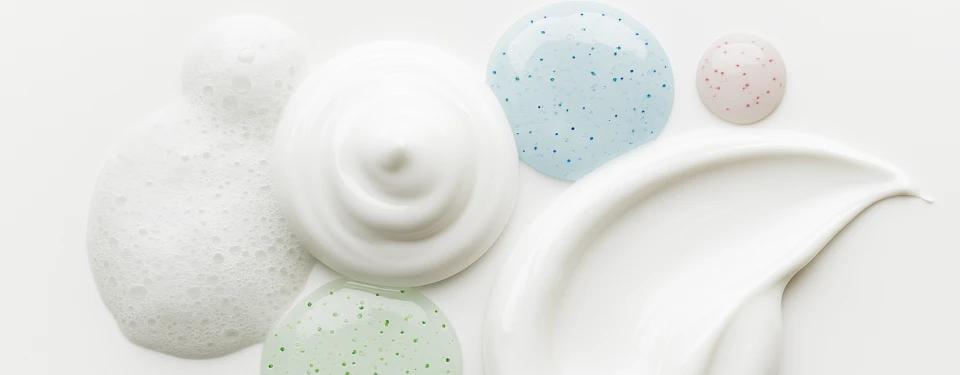Cosmetic Emulsifiers and Formula Stability
What is an emulsifier in cosmetics?
In the world of cosmetics, many formulations contain ingredients that don’t naturally mix well. A classic example is water and oil: when combined, they tend to separate. This is where an emulsifier comes into play.An emulsifier is a key ingredient that allows two immiscible liquids, such as water and oil, to blend into a stable and homogeneous mixture called an emulsion. It works by reducing the surface tension between the two phases, enabling one to disperse within the other without separating over time.
How does an emulsion work?
An emulsion is made up of two phases:- Dispersed phase: the liquid that is distributed in small droplets.
- Continuous phase: the medium in which those droplets are dispersed.
The interaction between both phases, along with the nature of the emulsifier used, determines the texture, stability, and skin feel of the final product.
Most common types of emulsions
In cosmetics, the two most common types of emulsions are:- O/W (oil-in-water): small oil droplets dispersed in a water-based medium. These emulsions are typically light, fast-absorbing, and fresh to the touch. Ideal for facial products, light moisturizers, or body lotions.
- W/O (water-in-oil): water droplets dispersed in an oil-based medium. These emulsions tend to be more nourishing, water-resistant, and suitable for dry skin or protective creams.
The type of emulsifier used depends on its affinity for water or oil, measured by a value known as HLB (Hydrophilic-Lipophilic Balance):
- High HLB emulsifiers are more water-soluble and used in O/W emulsions.
- Low HLB emulsifiers are more oil-soluble and used in W/O emulsions.
Often, multiple emulsifiers are combined to enhance the stability and texture of the emulsion by leveraging their synergistic properties.
Why are emulsifiers important in cosmetics?
Emulsifiers not only stabilize the formula but also directly affect the product’s texture, sensory experience, and performance. A well-formulated emulsion ensures that active ingredients are evenly distributed, enhancing the effectiveness of the cosmetic treatment.Stability in cosmetic formulations: Keys to long-lasting emulsions
When developing cosmetic products that are both effective and pleasant to use, emulsion stability is a crucial factor. If you’ve ever seen water and oil separate over time, you’ve witnessed what happens when an emulsion is unstable.While vigorous shaking may temporarily disperse one phase into the other (the greater the agitation, the smaller the resulting droplets), over time, these droplets tend to regroup. This leads to the emulsion losing its original consistency, eventually separating into its two base phases: aqueous and oily.
That’s why we say that a cosmetic emulsion is thermodynamically unstable—and this is where the expertise of a professional cosmetic formulator becomes essential.
How to improve the stability of a cosmetic emulsion
To create a stable and long-lasting emulsion—especially in natural cosmetics or facial care products—the formulator may apply several strategies:✅Increase the viscosity of the continuous phase to hinder droplet movement and prevent coalescence.
✅Reduce the droplet size of the dispersed phase and ensure they are as uniform as possible.
✅Reinforce the mechanical strength of the interface between the phases to make it more resistant to separation.
✅Decrease the surface tension, facilitating the formation of a more stable mixture.
Most of these techniques are directly related to the use of cosmetic emulsifiers, which—as mentioned—enable and stabilize the union of otherwise immiscible phases.
In many cases, emulsifiers used in cosmetics are also surfactants, meaning they alter the surface tension between water and oil, allowing for an effective and long-lasting blend.
Understanding how emulsifiers work and how to stabilize an emulsion is essential for formulating effective, safe, and pleasant-to-use cosmetic products. Whether it's a light facial cream or a nourishing balm, achieving good emulsion stability is key to ensuring the quality and durability of the final product.
Recommended Emulsifiers from Lemmel’s Portfolio
To help you formulate effective and stable cosmetic products, here’s a selection of emulsifiers from our portfolio, organized by emulsion type:O/W Emulsifiers (Oil in Water)
Ideal for light, fast-absorbing textures, perfect for facial and body care. These emulsions feature a water-based external phase, delivering freshness and a non-greasy feel.INCI: Cetearyl Glucoside (and) Sorbitan Stearate (and) Cetearyl Alcohol (and) Disodium Cetearyl Sulfosuccinate
➤ Creates smooth, creamy, fast-absorbing emulsions
➤ Rich texture with non-greasy finish
➤ Recommended for facial and body care products
INCI: Sucrose Polystearate (and) Cetearyl Alcohol (and) Olea Europaea (Olive) Oil Unsaponifiables
➤ Light, refreshing emulsions
➤ Immediate hydration with a lightweight feel
➤ Ideal for oily skin
➤ Forms liquid crystal structures
➤ Recommended dosage: 3–5%
INCI: Glyceryl Stearate (and) Cetearyl Alcohol (and) Sodium Stearoyl Lactylate
➤ Nourishing emulsion with aqueous external phase
➤ High emulsifier content for greater viscosity
➤ Suitable for normal skin
INCI: Trilaureth-4 Phosphate
➤ Versatile texturizer, ideal for complex formulations
➤ Great for formulators seeking a flexible solution
W/O Emulsifiers (Water in Oil)
Perfect for richer textures and water-resistant products. The oily external phase provides greater protection and prolonged hydration—ideal for dry skin or sun care.INCI: Glyceryl Oleate (and) Polyglyceryl-3 Polyricinoleate (and) Olea Europaea (Olive) Oil Unsaponifiables
➤ Lighter texture
➤ Suitable for dry skin, immediate hydration effect
INCI: Polyglyceryl-3 Polyricinoleate (and) Sorbitan Oleate
➤ Excellent compatibility with UV filters
➤ Time-saving—cold-processable
➤ Suitable for dense formulations like sun care or night creams
INCI: Polyglyceryl-2 Sesquiisostearate (and) Beeswax (and) Microcrystalline Wax (and) Mineral Oil (and) Magnesium Stearate (and) Aluminum Stearate
➤ Efficient and easy-to-use emulsifier
➤ Suitable for cold or hot process formulations
Need help with your cosmetic formulation?
If you have questions about which emulsifier to choose or need guidance to develop stable and effective formulations, don’t hesitate to get in touch with us. At Lemmel, we specialize in the distribution of cosmetic raw materials and are here to help you create innovative, safe, and tailored products.
Contact us for personalized support.
